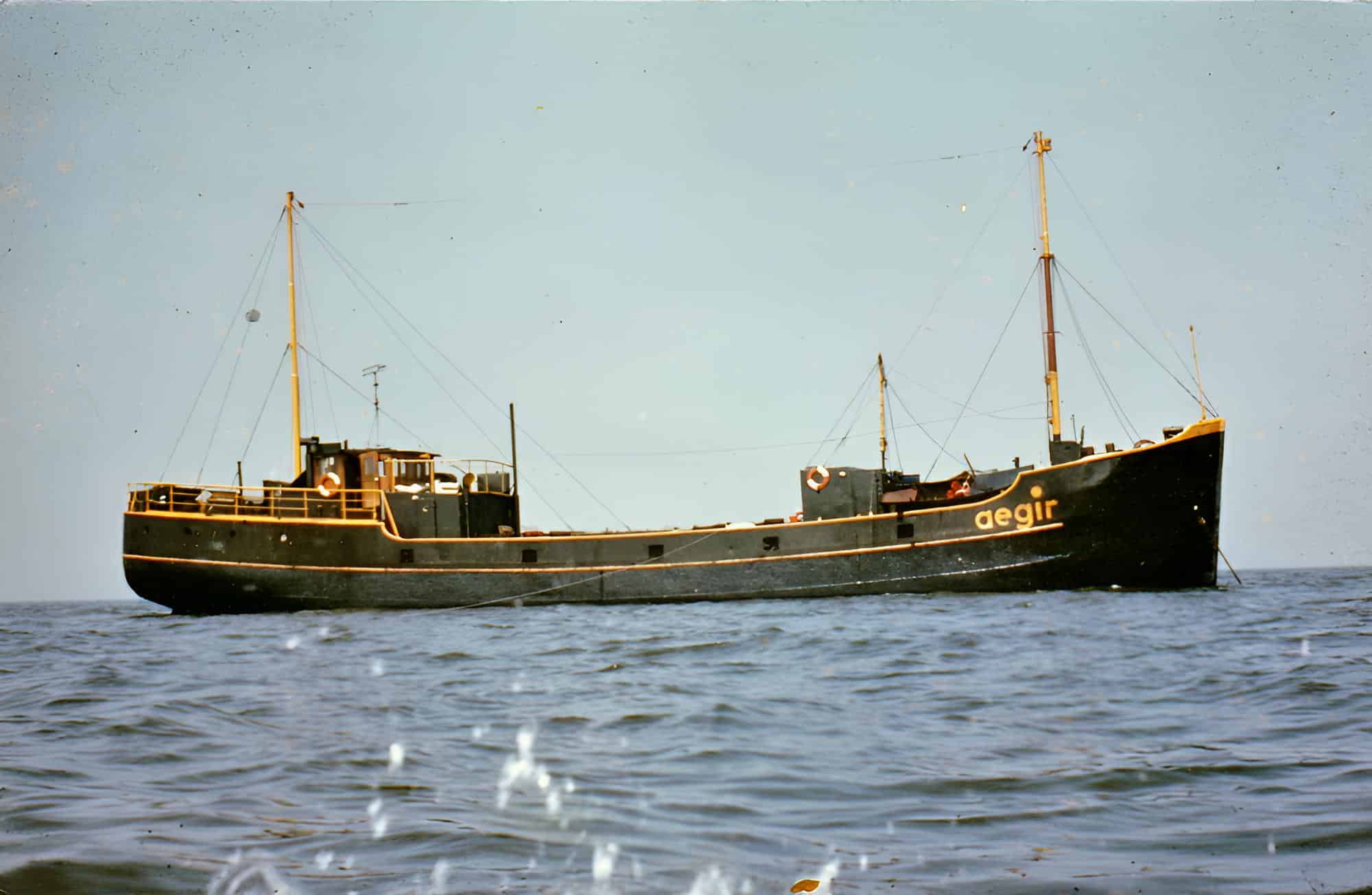Ship details: Length 36 metres, width 7 metres, tonnage 250, Deutz 250 pk motor, 15 kva and 10 kva generators.
Built in 1929 as ‘Express 5003760’ by Gideon, v/h J. Koster Hzn., Groningen for N.V. Motorschip “Express”, Rotterdam (under leadership of N.V. Scheepvaart Mij. Globus, Rotterdam).
In 1931, the vessel was sold to Wm. H. Müller & Co. N.V., Rotterdam (“Thuishaven Rotterdam”, page 89).
In May 1977, the Aegir was bought by the people setting up Radio Delmare. They worked hard to make the vessel sea worthy and to be able to broadcast. The first drawback came on Friday June 23rd 1978 when people by the Dutch RCD (Radio Control Office) and police boarded the ship. The father of one of the crew members didn’t want to see his son taking part in the adventure and had notified the authorities. With a truck the officials removed mediumwave- and FM-transmitters, the whole studio line-up, thousands of records, the tape archive, books, diagrams etc. The estimated damage was about 20.000 Euro. Luckily enough the ship wasn’t confiscated and the Radio Delmare people immediately sailed into the open sea. Food, oil and everything else was still on board.
In early July they sailed into the harbour of Maassluis (near Rotterdam) with the name of the ship temporarily having changed to “Flip”. Two weeks later they entered the town Hendrik-Ido-Ambacht, where the anchorchain was pulled onboard. On 16th July they sailed through the Zeelandbrug (Zeeland bridge) to Oostende (Belgium) where a week later the transmitters were brought on board. From Oostende the Aegir had to be towed to the coast off Goeree due to difficulties with its engine, a fact that became very crucial in the coming events.
The equipment brought onboard in Oostende comprised two 3 kW Marconi transmitters originating from the Belgium army. When bringing them on board they had suffered some damage, especially the endtubes. Therefore the first broadcasts had to be low powered: Only a few hundred Watts were pulled out of the transmitters, but because of the advertisers the radio station had to go on the air. The studio equipment contained 2 Revox A77 reel recorders, 4 FTM spotmasters, 2 Thorens turntables, 2 AKG microphones and a mixer with multi channels.
On August 24th Radio Delmare lost the “Mathilde Simone”, a lugger from Scheveningen which was once in a while used for tendering. A rubber dinghy dropped by the “Mathilde Simone” came into problems when its engine failt and was “rescued” by pilotage. The officer Mr. Pieters regarded that as the proof that the “Mathilde Simone” was used for tendering purposes.
In the early morning of 11th September 1978 the vessel lost its anchor in a force 8 gale. Only the Dutch discjockeys Rene de Leeuw and Jan Römer and the Belgian technician Johan Rood were on board. When Rene woke up, he noticed that the Aegir was approaching the coast. After alarming the other crew members the three of them tried to get the engine run, though since they had left Oostende (Belgium) they hadn’t been able to repair it. Therefore all attempts were fruitless. The only thing left to be done was to turn the transmitter on and to broadcast an SOS call which took place at 09.20 a.m. that morning. With “War Of The Worlds” by (the station’s theme tune by Jeff Wayne) playing in the background Rene de Leeuw desperately asked for help and read out telephone numbers in The Hague which listeners should call to explain the situation. The message was received and passed on by Scheveningen Radio, so after some time the tugboat “Smitbank” arrived and towed the “Aegir” into the harbour of Maassluis. On its arrival the ship was immediatly boarded by a small army of police men and officers by the RCD, amongst them Mr. Roth. The police examined the crew members but after a few hours they were free to leave. Then the Aegir was towed from Maassluis to the Entrepothaven in Rotterdam were she was anchored next to the “Mathilde Simone”.
Offshore radio station: Radio Delmare from 21st August to 11th September 1978
Location: International waters off Goeree/Zeeland (Netherlands)

